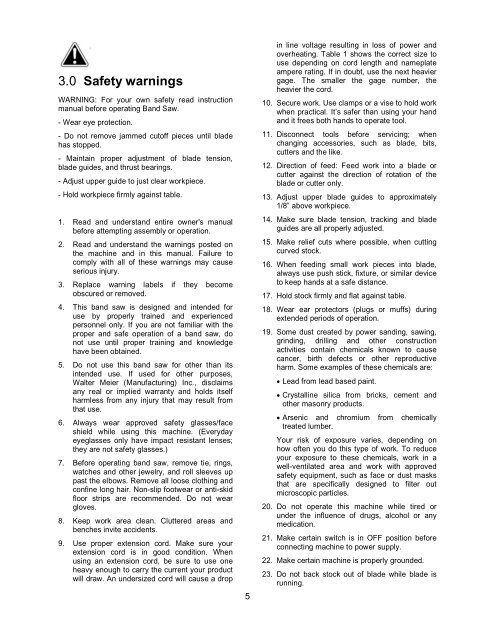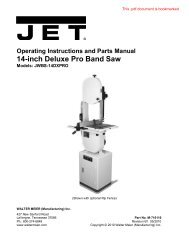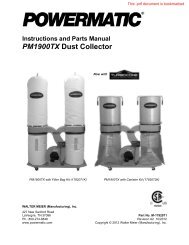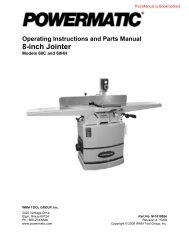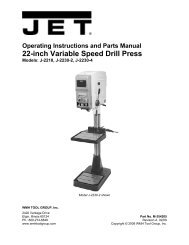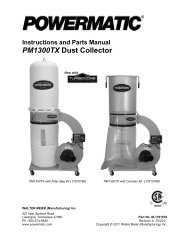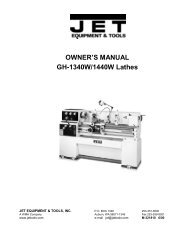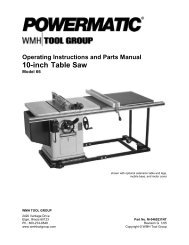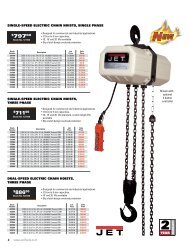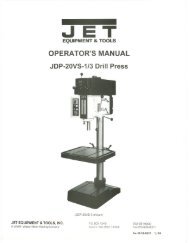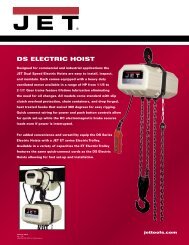You also want an ePaper? Increase the reach of your titles
YUMPU automatically turns print PDFs into web optimized ePapers that Google loves.
3.0 Safety warnings<br />
WARNING: For your own safety read instruction<br />
manual before operating Band Saw.<br />
- Wear eye protection.<br />
- Do not remove jammed cutoff pieces until blade<br />
has stopped.<br />
- Maintain proper adjustment of blade tension,<br />
blade guides, and thrust bearings.<br />
- Adjust upper guide to just clear workpiece.<br />
- Hold workpiece firmly against table.<br />
1. Read and understand entire owner's manual<br />
before attempting assembly or operation.<br />
2. Read and understand the warnings posted on<br />
the machine and in this manual. Failure to<br />
comply with all of these warnings may cause<br />
serious injury.<br />
3. Replace warning labels if they become<br />
obscured or removed.<br />
4. This band saw is designed and intended for<br />
use by properly trained and experienced<br />
personnel only. If you are not familiar with the<br />
proper and safe operation of a band saw, do<br />
not use until proper training and knowledge<br />
have been obtained.<br />
5. Do not use this band saw for other than its<br />
intended use. If used for other purposes,<br />
Walter Meier (Manufacturing) Inc., disclaims<br />
any real or implied warranty and holds itself<br />
harmless from any injury that may result from<br />
that use.<br />
6. Always wear approved safety glasses/face<br />
shield while using this machine. (Everyday<br />
eyeglasses only have impact resistant lenses;<br />
they are not safety glasses.)<br />
7. Before operating band saw, remove tie, rings,<br />
watches and other jewelry, and roll sleeves up<br />
past the elbows. Remove all loose clothing and<br />
confine long hair. Non-slip footwear or anti-skid<br />
floor strips are recommended. Do not wear<br />
gloves.<br />
8. Keep work area clean. Cluttered areas and<br />
benches invite accidents.<br />
9. Use proper extension cord. Make sure your<br />
extension cord is in good condition. When<br />
using an extension cord, be sure to use one<br />
heavy enough to carry the current your product<br />
will draw. An undersized cord will cause a drop<br />
5<br />
in line voltage resulting in loss of power and<br />
overheating. Table 1 shows the correct size to<br />
use depending on cord length and nameplate<br />
ampere rating. If in doubt, use the next heavier<br />
gage. The smaller the gage number, the<br />
heavier the cord.<br />
10. Secure work. Use clamps or a vise to hold work<br />
when practical. It’s safer than using your hand<br />
and it frees both hands to operate tool.<br />
11. Disconnect tools before servicing; when<br />
changing accessories, such as blade, bits,<br />
cutters and the like.<br />
12. Direction of feed: Feed work into a blade or<br />
cutter against the direction of rotation of the<br />
blade or cutter only.<br />
13. Adjust upper blade guides to approximately<br />
1/8” above workpiece.<br />
14. Make sure blade tension, tracking and blade<br />
guides are all properly adjusted.<br />
15. Make relief cuts where possible, when cutting<br />
curved stock.<br />
16. When feeding small work pieces into blade,<br />
always use push stick, fixture, or similar device<br />
to keep hands at a safe distance.<br />
17. Hold stock firmly and flat against table.<br />
18. Wear ear protectors (plugs or muffs) during<br />
extended periods of operation.<br />
19. Some dust created by power sanding, sawing,<br />
grinding, drilling and other construction<br />
activities contain chemicals known to cause<br />
cancer, birth defects or other reproductive<br />
harm. Some examples of these chemicals are:<br />
• Lead from lead based paint.<br />
• Crystalline silica from bricks, cement and<br />
other masonry products.<br />
• Arsenic and chromium from chemically<br />
treated lumber.<br />
Your risk of exposure varies, depending on<br />
how often you do this type of work. To reduce<br />
your exposure to these chemicals, work in a<br />
well-ventilated area and work with approved<br />
safety equipment, such as face or dust masks<br />
that are specifically designed to filter out<br />
microscopic particles.<br />
20. Do not operate this machine while tired or<br />
under the influence of drugs, alcohol or any<br />
medication.<br />
21. Make certain switch is in OFF position before<br />
connecting machine to power supply.<br />
22. Make certain machine is properly grounded.<br />
23. Do not back stock out of blade while blade is<br />
running.


